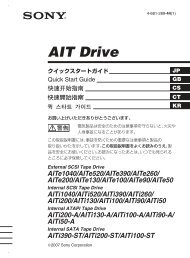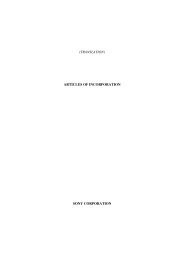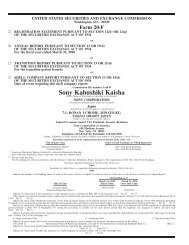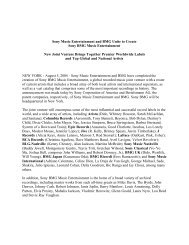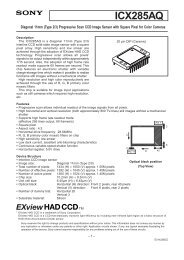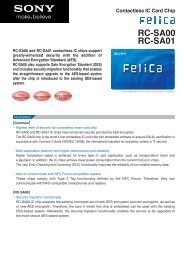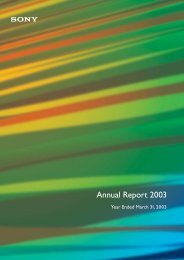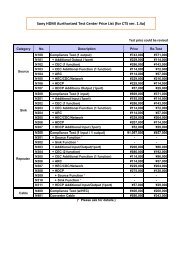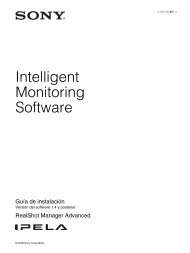PDF [4833KB] - Sony
PDF [4833KB] - Sony
PDF [4833KB] - Sony
You also want an ePaper? Increase the reach of your titles
YUMPU automatically turns print PDFs into web optimized ePapers that Google loves.
der recent conditions, management considers<br />
that it is possible that <strong>Sony</strong> Corporation’s future<br />
results may yield sufficient negative evidence<br />
to support the conclusion that it is more<br />
likely than not that <strong>Sony</strong> Corporation will not<br />
realize the tax benefit of all these deferred tax<br />
assets. If this is the case, subject to review of<br />
relevant qualitative factors and uncertainties,<br />
<strong>Sony</strong> may establish a valuation allowance<br />
against part or all of the deferred tax assets of<br />
<strong>Sony</strong> Corporation that would be charged to<br />
income as an increase in tax expense.<br />
As of March 31, 2004, the U.S. subsidiaries<br />
of <strong>Sony</strong> had a valuation allowance of 81.0<br />
billion yen against deferred tax assets for<br />
federal and certain state taxes. Since the U.S.<br />
subsidiaries did not have a sufficient history of<br />
taxable income at this time to conclude that it<br />
is more likely than not that the tax benefit from<br />
these deferred tax assets would be realized, a<br />
valuation allowance was established. Management<br />
believes this lack of sufficient earnings<br />
history, when evaluated in connection with<br />
relevant qualitative factors and uncertainties<br />
concerning the U.S. subsidiaries’ businesses<br />
and industries, provided substantial negative<br />
evidence, which outweighs any positive evidence,<br />
regarding the eventual realizability of<br />
the tax benefit of the deferred tax assets as of<br />
March 31, 2004. However, under recent<br />
conditions, management considers that it is<br />
possible that the U.S. subsidiaries’ future<br />
results may yield sufficient positive evidence to<br />
support the conclusion that it is more likely<br />
than not that the U.S. subsidiaries could realize<br />
the tax benefit of these deferred tax assets and<br />
that such a conclusion may be reached as early<br />
as during the fiscal year ending March 31,<br />
2005. If this is the case, subject to review of<br />
relevant qualitative factors and uncertainties,<br />
<strong>Sony</strong> may reverse part or all of the valuation<br />
allowance that would be recognized into<br />
income as a reduction to tax expense.<br />
FILM ACCOUNTING<br />
An aspect of film accounting that requires the<br />
exercise of judgment relates to the process of<br />
estimating the total revenues to be received<br />
throughout a film’s life cycle. Such estimate of<br />
a film’s ultimate revenue is important for two<br />
reasons. First, while a film is being produced<br />
and the related costs are being capitalized, it is<br />
necessary for management to estimate the<br />
ultimate revenue, less additional costs to be<br />
incurred, including exploitation costs which are<br />
expensed as incurred, in order to determine<br />
whether the value of a film has been impaired<br />
and thus requires an immediate write off of<br />
unrecoverable film costs. Second, the amount<br />
of film costs recognized as cost of sales for a<br />
given film as it is exhibited in various markets<br />
throughout its life cycle is based upon the<br />
proportion that current period actual revenues<br />
bear to the estimated ultimate total revenues.<br />
Management bases its estimates of ultimate<br />
revenue for each film on several factors including<br />
the historical performance of similar genre<br />
films, the star power of the lead actors and<br />
actresses, the expected number of theaters at<br />
which the film will be released, anticipated<br />
performance in the home entertainment,<br />
television and other ancillary markets, and<br />
agreements for future sales. Management<br />
updates such estimates based on the actual<br />
results to date of each film. For example, a film<br />
that has resulted in lower than expected theatrical<br />
revenues in its initial weeks of release<br />
would generally have its theatrical, home video<br />
and distribution ultimate revenues adjusted<br />
downward; a failure to do so would result in<br />
the understatement of amortized film costs<br />
for the period. Since the total film cost to be<br />
amortized for a given film is fixed, the estimate<br />
of ultimate revenues impacts only the timing<br />
of film cost amortization.<br />
FUTURE INSURANCE POLICY BENEFITS<br />
Long-term liabilities for future policy benefits<br />
are established in amounts adequate to meet<br />
the estimated future obligations of policies in<br />
force. These liabilities are computed by the net<br />
level premium method based upon estimates<br />
as to future investment yield, mortality, morbidity,<br />
withdrawals and other factors. Future<br />
policy benefits are computed using interest<br />
rates ranging from approximately 1.00 percent<br />
to 5.50 percent. Mortality, morbidity and withdrawal<br />
assumptions for all policies are based<br />
on either the life insurance subsidiary’s own<br />
experience or various actuarial tables. Generally<br />
these assumptions are “locked-in” upon the<br />
issuance of new insurance. While management<br />
believes that the assumptions used are appropriate,<br />
differences in actual experience or<br />
changes in assumptions may affect <strong>Sony</strong>’s<br />
future insurance policy benefits.<br />
For a summary of <strong>Sony</strong>’s significant accounting<br />
policies, including the critical accounting<br />
policies discussed above, please see Note 2 of<br />
Notes to the Consolidated Financial Statements.<br />
RECENTLY ADOPTED ACCOUNTING<br />
STANDARDS<br />
EMPLOYERS’ DISCLOSURES ABOUT PENSIONS<br />
AND OTHER POSTRETIREMENT BENEFITS<br />
In December 2003, the FASB revised Statement<br />
of Financial Accounting Standards (“FAS”)<br />
No. 132, “Employers’ Disclosures about Pensions<br />
and Other Postretirement Benefits”, an amendment<br />
of FAS No. 87, “Employers’ Accounting<br />
for Pensions”, FAS No. 88, “Employers’<br />
Accounting for Settlements and Curtailments of<br />
Defined Benefit Pension Plans and for Termination<br />
Benefits”, and FAS No. 106, “Employers’<br />
Accounting for Postretirement Benefits Other<br />
Than Pensions”. The new FAS No. 132 revised<br />
employers’ disclosures about pension plans and<br />
other postretirement benefit plans. It did not<br />
change the measurement or recognition of<br />
those plans required by FAS No. 87, 88 and<br />
106. While retaining the disclosure requirements<br />
of FAS No. 132, the new FAS No. 132<br />
requires additional disclosures about assets,<br />
obligations, cash flows, and net periodic benefit<br />
costs of defined benefit plans and other defined<br />
benefit postretirement plans. The provisions of<br />
the new FAS No. 132 are generally effective for<br />
financial statements with fiscal years ending<br />
after December 15, 2003, excluding the disclosure<br />
of certain information about foreign plans,<br />
which shall be effective for fiscal years ending<br />
after June 15, 2004. In accordance with the<br />
transition provisions of the new FAS No. 132,<br />
the disclosure provisions have been adopted in<br />
the consolidated financial statements.<br />
87


![PDF [4833KB] - Sony](https://img.yumpu.com/26420643/89/500x640/pdf-4833kb-sony.jpg)
